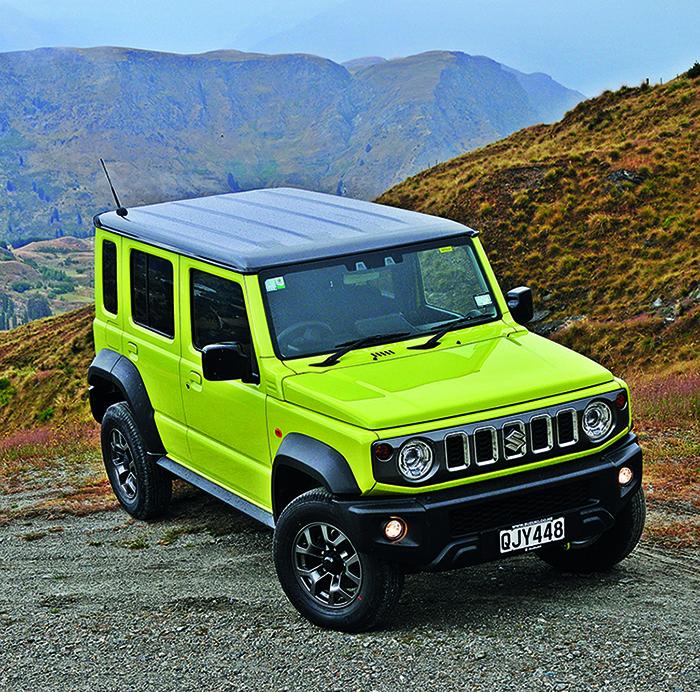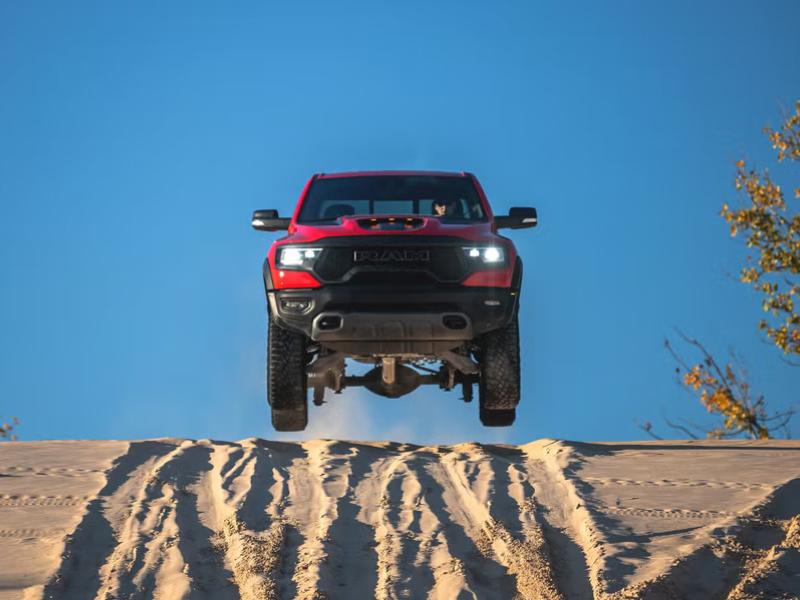There are only a handful of 4WDs that can genuinely lay claim to being ‘cult’ vehicles. Most of them occupy price landscapes well north of $70,000.
Uniquely, Suzuki’s Jimny is truly cult and costs less than half that amount.
The cheeky three-door has no direct competitor and its sales in New Zealand have only been limited by stock availability.
Buy it, drive it around the city, love it for its wheel-at-each-corner practicality and excellent view of the road.
Buy it, drive it on soft-roading adventures like the South Island’s Skippers Canyon, love it for its light weight and agility.
Buy it, throw bars, all-terrain tyres and wheels at it, and it will go places most people never dare dream, of going.
As a first 4WD, as a young couple’s adventure wagon, the three-door Jimny has no rival.
Rumoured since the launch of the current JB74 Jimny in 2019, the arrival of a five-door version opens up a whole new group of potential owners: those who need to transport up to four people and luggage – or toys.
Attention young families, this is the Jimny designed to do everything required by mum, dad and the kids.
The three and five-door versions of Jimny have identical engines and both offer five speed manual and four speed auto transmissions. In bigger trucks that might be more of an issue, but the five-door only weighs 100kg more than the three-door – less than your average Kiwi bloke! Seriously though, the five-door still tips the scales under 1200kg.
Fuel economy is reasonably good: where the three-door does 6.4-6.9l/100km (manual/auto), the five-door returns 7.1-7.7l/100km respectively.
The transmissions are kinda old-school: a five-speed manual with 1:1 fifth gear, and a four-speed auto.
For off-road work, the preference would always be for the manual, though with a relatively small four-cylinder engine the downhill ‘braking’ effect is pretty muted. That’s where hill descent control saves the day.
The gap between first and second in high range was a bit unsettling, especially off the tarmac; another ratio between the two would have helped but as it was, we found ourselves pogo-ing between potholes left by bigger vehicles, unable to find a comfortable brace position for the accelerator foot.
The five door carries extra length in and behind the wheelbase; the wheelbase is 340mm longer at 2590mm vs 2250mm. It retains the excellent approach and departure angles of the three-door, which are likely the best on any 4WD available. How does 37 degrees approach, 210mm ground clearance and a whopping 49 degrees departure angle sound? The ramp-over is just slightly shy of the three door’s 28 degrees.
To keep things rigid, the longer chassis has an extra crossmember and has been strengthened, mounts are also beefed up. The extra length is a sigh of relief for rear seat passengers; the Jimny 5’s rear bench seat does only allow for two occupants. It also creates more luggage space, up significantly over the three-door.
The luggage bay of the five door is longer by 367mm. The rear seats have a two-tier split folding function, and there’s a 12-volt socket in the luggage area. Capacity goes up from 85 litres to 211 litres.
On the road, the five-door is measurably smoother at the rear, the wheelbase boost giving a different dynamic to the back of the vehicle. The other area Suzuki has worked on is road noise, the five-door cruising more quietly on or off the road.
Inside there are some updates, chief among them the adoption of a 9.0-inch infotainment system from the S-Cross hybrid. Controls for the rear side windows are set into the centre console, while front window controls remain on the lower dash.
Our trip from the airport was a bit squashy – big Kiwi blokes crammed into three-door Jimnys – but that gave a clear appreciation of the comfort and practicality upgrade available in the five-door.
Other media have noted that the three-door’s ANCAP rating does not ‘umbrella’ across to the five, and that the existing rating expires at the end of this year. Almost every vehicle sold in New Zealand has a safety rating from either Australian (ANCAP) or European (Euro-NCAP) New Car Assessment Programmes.
Jimny 5 is not safety-stripped by any means, it’s fitted with six airbags, stability control, anti-lock brakes (of course) and frontal AEB.
The five-door could be tested, and the three-door retested, but that decision rests with Suzuki Japan. Neither rating system is compulsory for new vehicle sales here, and other vehicles including the Chev Silverado and Ineos Grenadier have gone on sale here without ratings.
That lack of an ANCAP rating puts Jimny out of consideration for larger fleets, but it remains firmly in focus for a wide range of other buyers including small business owners who appreciate the 4WD’s value as a distinctive mobile billboard for their companies in three or five door form.
Other customers will be trading up from the three-door in search of more interior room.
Add in the young families, new arrivals to the brand, who will find the five-door entirely practical for urban and weekend adventure use.
Then there are those who will toddle straight off to their local 4WD workshop to up-armour their Jimny for off-road use.
Top that off with 50+ owners who like the looks and practicality of the Jimny, and the Gray Nomad set who have been buying the current Jimny to tow behind their motor homes.
It seems Suzuki will do just fine without the fleet segment that it never actually targeted in the first place.
Choked by supply issues, the company sold almost 800 Jimny three doors last year; this year projections are for the five-door to equal that number. Suzuki says the split of manual vs auto is about 50/50, with initial shipments of the new vehicle being restricted to manual versions only.
Suzuki holds 1000 forward orders for five-door Jimnys. Some are owners of the current three-door, but many are newcomers to the brand. In Australia, the waiting list for Jimny 5 is already out to nine months.
As media have noted, it only took 50-odd years for a five door to arrive. But then, Suzuki does have some of the longer model lifespans in the automotive world.
Soft-roading in Skippers
For the drive part of the launch, Suzuki took the media up Skipper’s Canyon, all the way to the restored schoolhouse and campground. This trail is famous and infamous in equal measure. Only – or barely – one vehicle wide in much of its length, it is used by small buses that bring willing tourists to the Skippers Canyon Jet boat tours. It’s also used by Nomad Safaris, who tour the canyon and provide visitors with an excellent insight into the privations faced by the gold miners who plied their trade in this bleak place, enduring weeks of sub-zero temperatures in winter.
What is not seen on the trail is any sign of a rental car. The Canyon is absolutely off limits across all rental car companies. Fortunately.
The Skipper’s Canyon trail was perfect territory to experience the five-door, challenging enough in the scary view out the side windows but not too tough in terms of terrain. The road surface was dry but studded with potholes and plate-sized pieces of schist rock.
The vehicles NZ4WD drove and rode in were all on narrow road treads but grip was never an issue, even on the sand and gravel banks down by the river. First pick was the very bright yellow also seen on other Suzuki models. We figured it would look good even on the dull overcast day we drove it. The five-door’s hero colour is red, which is also good. Extroverts will go for either colour, hardly looking sideways at the more muted tones.
Heading in, we took things slowly, very aware of the huge drops immediately alongside the Jimny’s right hand wheels. Steering feedback was good, visibility also good out that very upright windscreen.
After several stops at photo points the convoy gathered beside the river where driver pairings swapped between manual and auto Jimnys. There were three-door Jimnys available, but most journalists had driven the shorter Jimny in the past.
From the Skippers Jet landing on and up into the upper reaches of the Canyon, we switched to an auto, and though it’s just a four-speed, the trans dealt well with the soft-road adventure. This suggests the auto would be perfectly fine for most uses, though the manual was the favourite of most writers. With a vehicle at such a competitive price-point, it would be silly to wish for an eight or ten-speed unit. And heaven forbid someone in Japan decide to change to a CVT.







